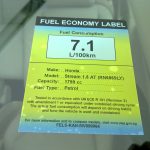 While waiting for my car the other day, I looked around the Kah Motor showroom and noticed the new fuel economy label stuck on the windscreens of all the cars. It’s the Mandatory Fuel Economy Labeling programme introduced by our National Environment Agency not too long ago, requiring all vehicles to undergo fuel economy testing, so that buyers can be better informed about the environmental impact of the vehicles they choose to drive.
While waiting for my car the other day, I looked around the Kah Motor showroom and noticed the new fuel economy label stuck on the windscreens of all the cars. It’s the Mandatory Fuel Economy Labeling programme introduced by our National Environment Agency not too long ago, requiring all vehicles to undergo fuel economy testing, so that buyers can be better informed about the environmental impact of the vehicles they choose to drive.
My Honda Stream is officially rated for 7.1 l/100km. That translates to about 14 km/l, for those (including myself) more familiar with the other common metric. Impressive! It is actually better than the similar engine sized Honda Civic 1.8, which is rated for 7.2 l/100km.
You can check NEA’s Fuel Economy Labeling database.
I’ve learnt to never trust the manufacturer’s fuel economy specifications. They seem too optimistic than what is possible with real world driving conditions in Singapore. Many factors are important: driving conditions, engine oil, fuel, tyre pressure, vehicle load, driving pattern (the “heaviness” of the driver’s foot), etc.
But when a national standard for fuel economy labeling is mandated, I thought we would get something realistic for Singapore’s driving condition. The numbers that meet NEA’s blessings, however, still fall far short of the actual fuel economy that I can achieve with my driving.
7.1 l/100km for a Honda Stream is really pretty good, if only that is what I actually get on my car.
Nevertheless, a national standard for fuel economy labeling will make it much easier to make comparison between cars. It’s a good thing to have.
View Comment Policy